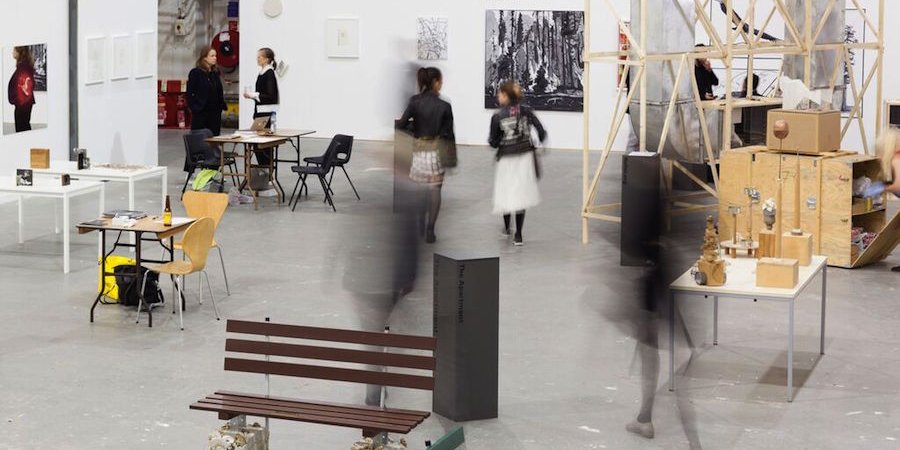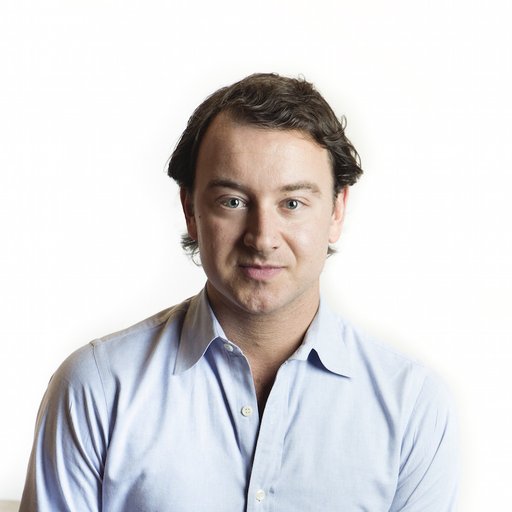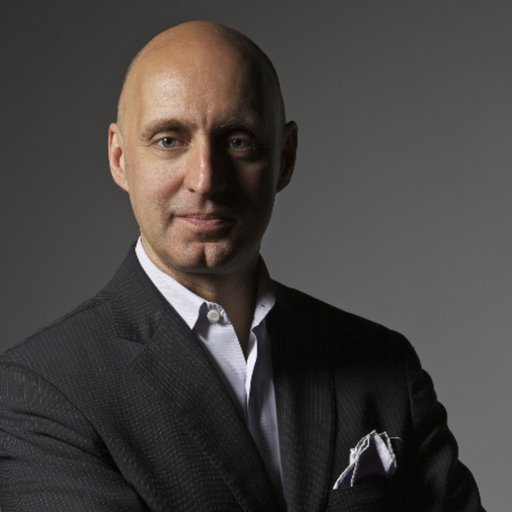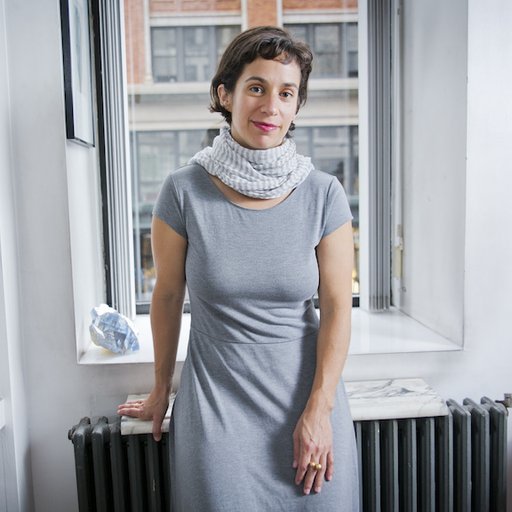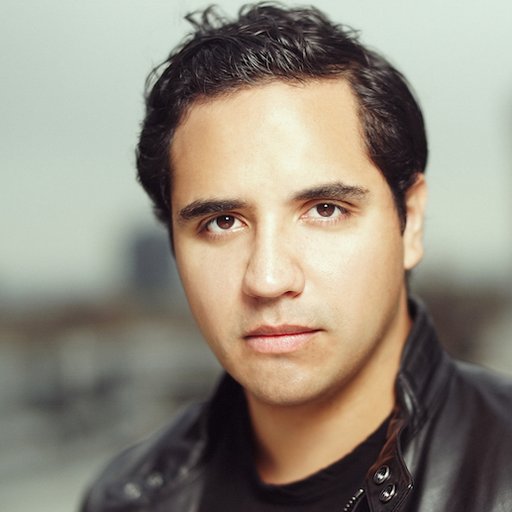A showcase for emerging artists who are often on the cusps of big careers, the Sunday Art Fair has long had a reputation as a wild and woolly affair, stemming from its ragtag roots as an improvisatory event founded by a trio of galleries during the 2010 Berlin Gallery Weekend. Since moving to London’s raw-boned P3 Ambika space—a former cement laboratory on the University of Westminster campus—the fair has seen its leadership passed down from its founders (London’s Limoncello, Berlin’s Croy Neilsen, and Brussels’s Tulips and Roses) to Rob Tufnell and, currently, to London’s Supplement gallery. Now those dealers, Thom O’Nions and Adam Thomas, are intent on transforming Frieze’s liveliest satellite fair from a secret of the in-crowd to a real business with expansionist ambitions.
This would be no small accomplishment, considering how successful the fair has been at bringing greater attention to artists (e.g. Ella Kruglyanskaya, AIDS 3D, Puppies Puppies, Nicolas Ceccaldi, Simon Fujiwara, and Oliver Laric) and galleries (e.g. Rodeo, SupporticoLopez, Simone Subal) alike. To find out more about Sunday’s plans, Artspace editor-in-chief Andrew M. Goldstein spoke to O’Nions.
What does it mean that Sunday is a gallery-organized fair? How does that differ in style and approach from other fairs?
It certainly has a bit more of a laid-back atmosphere—that’s what people always remark on about Sunday. It’s more experimental and playful, and it’s more flexible, with an industrial urban-plan aspect in terms of its layout. Also, it's unlike the other major fairs in that visitors don’t have to pay to get in. This year, though, we’ve begun to have an application process, and so we’ve really started a dialogue with the galleries about what they wanted to show and how they were going to make it work and what we can do to the space to kind of make it look more put-together.
Since Sunday has always been a kind of free-form, ad hoc event, why did you feel the need to start an applications process?
We thought it would be really beneficial to see what everyone was proposing and see how it sits together as a whole. But, in the end, it also opened us up to a lot of galleries that we didn’t know previously, and we tried to base our selections on the proposals rather than who the gallery was—which I think has given us a interesting mix of galleries this year. There are a few less established names, and more younger galleries. We purposely tried to stay fresh with galleries this year.
I see that there are a few artist-run operations, like Tomorrow Gallery. Are there any galleries on this list that are working with a new kind of format that you weren’t aware of or otherwise find intriguing?
Actually, they’re all quite traditional galleries in that sense. We did look at including more eclectic project spaces and more collective things, but we found they were quite limited, so it’s a fairly straight commercial fair. But next year we’re looking to expand and have a broader selection, with more project spaces and experimental things that we can subsidize with the fair.
How many years do you plan to run the fair?
I’m not sure really. Sunday has always been a bit haphazard before, and we’re trying to establish it more and put a lot of infrastructure in place so it can endure. We’re also looking to expand next year, so we’re trying to find a bigger space, which is difficult to do in Cambridge. We definitely plan on running it for a few years. I think it has such great potential, since it’s the only alternative fair in London during Frieze. And since a lot of the galleries at Sunday go on to participate in Frieze, it keeps our fair quite fresh.
How would you say Sunday’s audience overlaps with the Frieze audience?
There is absolutely overlap. What I think is good about a smaller fair like Sunday is that collectors tend to get overwhelmed by so many galleries at the bigger fairs, so they’re a little exhausted by the time they get to the smaller galleries in the focus sections. With something like Sunday, people go there with a specific frame of mind—they adjust their thinking to engage with a group of emerging artists and galleries. It really helps to be smaller, more manageable, and more contained, because a problem with art fairs in general is that it’s difficult to maintain a collector’s focus throughout.
So you think the answer to the fact that art fairs have gotten so unmanageably big is that we need to have more art fairs?
Yes. People complain there are too many art fairs, but what I see as the problem is that there are too many similar art fairs. We need more diverse types of fairs. I’m not sure what type they should be, but it’ll be interesting to see what emerges in the next couple of years.
Like more artisanal art fairs compared to the big-box art fairs.
Something like that, yes.
I think the big gripe about fairs is that there are so many all over the world that it has become a fixed cost for galleries that want to navigate the global marketplace. They have to travel to these fairs and push their artists to churn out work to satisfy the art-fair schedule. Sunday, however, has a very different feel, more like a farmer’s market.
[Laughs] It does have a different appeal to it. I think artists feel more comfortable making work for Sunday. They like how there’s a fluid transition from one gallery to the next. We also have so much more flexibility in terms of how we can present things, and the kind of work that we want to show.
What about for collectors—what is the draw of Sunday for them? How would you describe your audience?
Well, for one thing, the average price point is clearly not a lot. While people can be intimated by the larger fairs, and I think we’re nurturing a group of young collectors and supporters. London is filled with very wealthy people, and we have a great collection of galleries here that really support institutions. We’re trying to broaden that a bit and bring in more emerging galleries. I think there’s a really big audience here for that, and I think it’s really important.
What do you think an art fair should accomplish generally, as a larger mission than just selling art?
It's about the kind of dialogue you can start, isn’t it? About opening up discussions with people and giving exposure to artists who haven’t had that much yet. That’s what we can do with Sunday, and I think that’s important for the galleries. Obviously the commerce aspect is the reason that we do fairs, but it’s much more than that. It’s about dialogue and conversation.
So how much does it cost for a gallery to exhibit at Sunday?
It’s cheap—significantly cheaper than any other fair, really. We want to attract younger galleries that may not have as much money as the commercial galleries, so we keep the price very low.
Is there any salient trend in the group of galleries that you have this year?
One thing that’s quite interesting is that we received so many great applications from spaces in L.A. this year, and we have four of them in the fair. That’s sort of a highlight there. It seems that L.A. has this kind of high energy and opportunity right now, with all these kinds of spaces popping up. Those are the kinds of spaces that we are looking for. There are a lot of really great things coming out of LA.
What does it mean that there aren’t any galleries from South America or Asia or the Middle East on your list? Does that reflect the kind of applications that you received?
It definitely reflects the applications we’ve been receiving, and it’s something that we’re really aware of. We’d like to change that for next year. I think people aren’t aware of the fair in Latin America or Asia, so there’s a question of how we can engage galleries in those regions a bit more.
Now that you’re beginning to professionalize the fair and make it a bit more sustainable, are there any plans to expand it beyond London?
Yes, we are looking at starting another fair. We’ve been looking at Brussels, but it’s something that we’re thinking of approaching in different ways. Also, this year we’re launching additional programing that we’re going to run throughout the year. We started it with a set of six editions for this fair, and that’s going be something that we continue, where we work with younger artists and commission editions. This year it includes Steve Bishop, Kate Cooper, Eloise Hawser, and Yuri Pattison.
You mentioned that you’ve been paying attention to L.A. as an exciting wellspring of emerging galleries—is that a location that you would consider for a fair?
I think we see that as a possibility. They already have Paramount Ranch out there, but that’s kind of a different thing. Right now, though, we’ve been focusing more on Europe.











